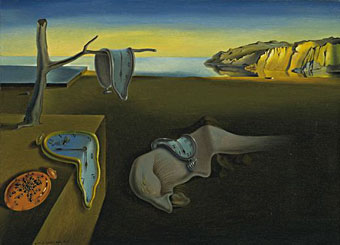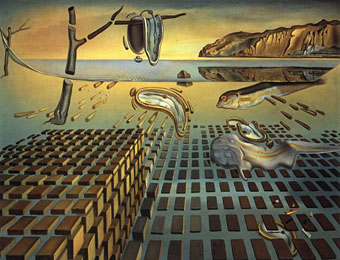
The Persistence of Memory (1931).
Forensic scientist uses DNA to explore Dalí’s bizarre genius
Samples taken from nasal feeding tubes could also help to authenticate works
James Randerson in San Antonio
The Guardian, Saturday, February 24, 2007
IT IS LIKE something from a surrealist still life—a hat, glasses, moustache and toilet seat. This is the collection of belongings that forensic scientist Michael Rieders was offered when he put the word out that he was trying to track down Salvador Dalí’s DNA.
“I have been fascinated by Dalí and his artwork since I was around 11 years old,” he said. “I found it hard to believe that a person could come up with such exotic, bizarre art.”
By tracking down Dalí’s DNA he felt he could get closer to the surrealist artist. But more than that, he hoped that if he could characterise Dalí’s DNA fingerprint, he could use it to help authenticate the handful of paintings and artworks that are not signed but are claimed by some to have been painted by the Spanish master.
Dalí’s DNA might even hold clues to the man’s creative genius. “He was just a machine of creativity at all levels,” said Bruce Hochman, director of the Dalí Gallery in San Juan, California. “Not only was he a great painter, he could work in any medium.” Dalí also designed jewellery, designed sets for Disney, wrote and starred in an opera and was an accomplished draughtsman.
When the “Dalí universe”, as Dr Rieders calls it, began offering to sell him objects to test for DNA he suspected most respondents were opportunists. But then he was given an unmissable chance of getting close to Dalí’s DNA.
Mr Hochman put Dr Rieders in touch with two of Dalí’s closest friends, Robert and Nicolas Descharnes. They had kept two nasal tubes nurses had used to feed the painter when he was recovering from a fire in 1984. The blaze, which was started by an electrical fault at his castle in Pubol, France, left Dalí with second degree burns on his leg and burns to his throat from breathing in the hot smoke.
“I’m not 100% sure why (they kept them),” said Dr Rieders, a toxicologist and lab director at NMS Labs in Willow Grove, Philadelphia, “but I now had an artefact that I was reasonably sure would contain some of Dalí’s DNA.”
The Descharnes, renowned authenticators of Dalí’s work, had stored the tubes in sealed envelopes signed and dated by Dalí’s doctor and nurse.
Dr Rieders told the annual meeting of the Academy of Forensic Sciences in San Antonio, Texas, that his team took swabs from 19 different places on the outside of the tubes. The profiles—which included DNA markers at 16 different sites on the chromosomes—all pointed in the same direction. “They all ended up coming back to a single male individual. This was a good sign,” he said.
The next step is what to do with the DNA. “Let’s be clear about this. I have no intention of creating a cloned army of surrealist artists,” said Dr Rieders, who sported a melting clock tie in honour of one of Dalí’s most famous images.

The Disintegration of the Persistence of Memory (1952?54).
One priority is to preserve the DNA for future testing. The team have offered one sample of the DNA to the Dalí Foundation in Spain, one to the Dalí Museum in St Petersburg, Florida, and one to the Forensic Archaeo-Toxicology Institute, an organisation that retains DNA samples from significant cases. “We want to make sure that if a catastrophe should happen in Willow Grove, Pennsylvania, we won’t lose the chance of having Dalí’s DNA,” said Dr Rieders. Dalí died in 1989 leaving no descendants.
One possibility would be to study Dalí’s DNA for clues to his artistic genius. Perhaps he had a mild form of schizophrenia or bipolar disorder which fuelled his creativity.
“Dalí collectors will want to use the DNA profile to help establish whether the huge amounts of supposed Dalí paraphernalia that exists is real. There are many Dalí objects out there, some on eBay, that are claimed to have been in the possession of Dalí,” said Dr Rieders.
“We now have the art world very interested in using this Dalí DNA reference as a way of looking to see if some of the other objects and artwork out there could perhaps be Dalí’s.”
One piece in particular, a small watercolour called The Snail and the Angel, has a brown stain on it that is supposedly Dalí’s semen. The authenticity of that painting is not in doubt, but Dr Rieders thinks it would be a good place to start to try out the DNA fingerprint.
Previously on { feuilleton }
• Salvador Dalí’s apocalyptic happening
• The music of Igor Wakhévitch
• Dalí Atomicus
• Las Pozas and Edward James
• Impressions de la Haute Mongolie

Pro Hart an aussie artist would put DNA signatures on his paintings to authenticate them
http://en.wikipedia.org/wiki/Pro_Hart
http://www.theage.com.au/articles/2002/03/06/1015365716233.html
Using DNA for authentication is a good idea, especially since there’s a lot of apparently fake late Dalís going around.
The implication that he was mentally ill in some way is as annoying as these suggestions always are. Some people feel compelled to “explain” inordinate talent and/or eccentricity in terms of illness.
A lot of the late Dali’s works seem to have been created by pupils rather than by himself, so the DNA use might be usefull to differenciate between the pricey and the cheapies (because I do believe this is what it is ultimately about).
But I really don’t care to know where the mechanics of his genius came from. It is not particularly relevant for the appreciation of his art.
Isn’t genius (as originality) a form of folly of its own ?
That without it you can only have talent ?
(That’s in relation to Jean Cocteau’s “Le talent fait ce qu’il veut, le genie fait ce qu’il peut” – in the case of Dali, both components were clearly there).
I’m not sure why people feel the need to explain artistic achievement in terms of physiological deficiency but there may be some belittling impulse behind it. Then people who do extraordinary things can be brought to a level where they seem “lesser” than everybody else. I mentioned this syndrome before in the post about Rembrandt’s eyes:
http://www.johncoulthart.com/feuilleton/2006/07/16/rembrandts-vision/
The proposal by some that Michelangelo may have had Asperger’s was based solely on scant biographical details such as “he was antisocial”. Well join the club, Buonarroti.
A lot of it is just jealousy of someone who is earning a living doing work the enjoy
“What is an artist? For every thousand pepole there’s nine hundred doing the work, ninety doing well, nine doing good, and one lucky bastard who’s the artist.” – Tom Stoppard in Travesties